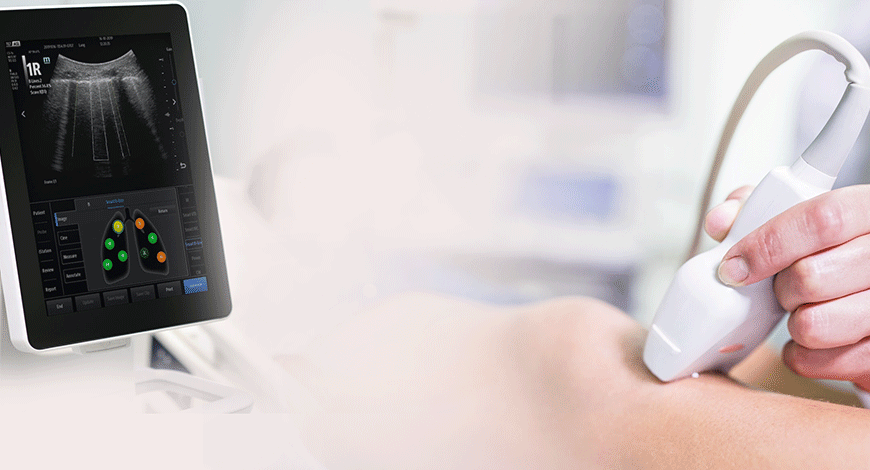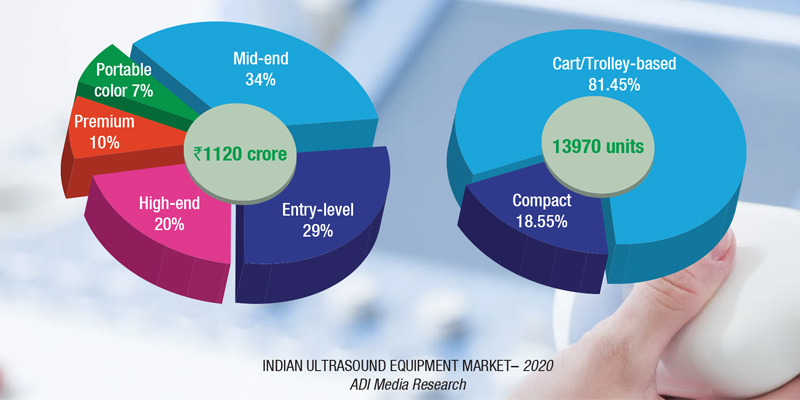Ultrasound Equipment
Ultrasound is making waves

Ultrasound is on the path to becoming even more automated, mobile, conclusive, and intuitive for users, making it an essential tool for patient diagnosis on a daily basis. New technology has revolutionized it to an imaging device of choice for a variety of clinical specializations that would have appeared impossible just a few decades ago.
Ultrasound imaging architecture, the underlying engineering design, and structure that enables an imaging platform to perform its wide and varied array of clinical applications, has evolved significantly over the past two decades. By integrating technological advances and innovative design elements into contemporary premium-level imaging systems, many of the constraints, associated with conventional imaging architecture, have been mitigated. This progress has opened the door to the introduction of novel diagnostic capabilities into the sonographic armamentarium.
The past decades have witnessed the emergence and rapid development of numerous new ultrasound imaging technologies, such as ultrafast ultrasound imaging (e.g., plane-wave imaging, diverging imaging), elasticity imaging (e.g., acoustic radiation force impulse imaging, shear-wave elastography, strain imaging), high-sensitivity microvascular imaging, high-frequency imaging, functional ultrasound imaging, and super-resolution ultrasound localization microscopy. Some of these novel technologies have been extensively studied and are broadly available in commercial scanners to benefit patient care, while others are still under active development. Undoubtedly, the advancement in ultrasound is leading to new opportunities in both basic research and clinical applications.
While the development of novel ultrasound technologies is inspiring, significant challenges remain to be addressed. These include both technical aspects (such as technical robustness and validation, computational burden regarding real-time imaging, temporal and spatial resolution improvement, signal-to-noise ratio improvement, artifact suppression), and scientific and clinical aspects (such as finding novel biomedical applications, clinical usefulness validation, feasibility, and reproducibility evaluation).
The Indian ultrasound market in 2020 is estimated at ₹1120 crore by value and 13,970 units by quantity. The market saw 8-percent decline by value and a 4-percent decline by quantity over 2019, indicating a shift away from the premium segment. This includes the refurbished machines, estimated at ₹40–50 crore in 2020.

By value, the market share of the premium segment in 2020 declined by 5 percent. The high-end and mid-end continued to have similar market shares as 2019. The entry-level gained a 6-percent share in 2020, over 2019.
By type, in a total market of 13,970 units, the cart/trolley-based machines dominated with 81.45-percent share, and the balance 18.55 percent was contributed by the compact machines.
GE continues to dominate this market with a huge lead over Philips, the next in the chain. Mindray and Samsung are neck-to-neck, while BPL, Sonoscape, and Toshiba are also aggressive players. Other brands that have presence include Trivitron, Hitachi, Sonosite, Esaote, Konica, and some Chinese brands.
|
Indian ultrasound equipment market |
||||
|
Major vendors* – 2020 |
||||
| Tier I | Tier II | Tier III | Tier IV | Others |
| GE | Philips | Mindray & Samsung | Siemens, BPL and Sonosite | Trivitron, Hitachi, Sonoscape, Esaote and Konica |
| *Vendors are placed in different tiers on the basis of their sales contribution to the overall revenues of the Indian ultrasound equipment market. | ||||
| ADI Media Research | ||||
COVID-19 prompted ultrasound to make the jump from a clinical to a domestic setting. Novice users are being empowered to use a tool that, to this day, many primary care physicians cannot.
Cost is still a barrier to increased adoption, but as that falls, it will just take one vendor, one provider, one insurer, just one company with a novel strategy to strike on the right model, which is both helpful and lucrative, before the floodgates open and ultrasound at home is an everyday occurrence.
Modern medical ultrasound technology has made tremendous advancements over the years with many breakthroughs. Some of the recent advances include the integration of AI, automation of functions and measurements, introduction of very specialized tool sets, the rapid growth in point-of-care systems, improved ergonomics, and on the horizon, the development of therapeutic ultrasound systems for cardiovascular and cancer therapies.
Features to increase workflow efficiency and automate workflows. Hospitals continue to ask ultrasound vendors to find ways to speed workflow to allow more patients to be scanned, while reducing the work required to complete an exam. Here are some examples of how vendors are addressing these concerns.
In January 2021, Philips introduced its Abdominal Aortic (AAA) Model, providing physicians a more patient-friendly solution compared to the current standard of care for managing AAA patients. Based on 3-D ultrasound, it delivers accurate diagnostic information without exposing patients to high doses of radiation and nephrotoxic contrast agents.
GE said at RSNA 2020 that its Logiq E10 continues to see reduced numbers of clicks needed for various tasks, more pre-populated reporting fields to reduce completion time after an exam, and enabling both of these features with the integration of more AI into the systems.
Intel and Samsung Medison announced a collaboration on new smart workflow ultrasound solutions to improve obstetric measurements that contribute to maternal and fetal safety.
The Canon i-series FlexStyle allows the sonographer to personalize key functions, so the buttons they are used to can be in the same place as a previous system, or other vendors’ systems. The goal is to make the transition to the new system very easy.
Adding AI to ultrasound systems increases diagnostic capabilities.
Contrast-enhanced ultrasound. Advances in ultrasound, known for its safety, low cost, patient tolerability, and system mobility, are especially promising. The most recent is contrast-enhanced ultrasound (CEUS), an emerging technology used in cardiac and abdominal imaging for decades outside the US. The introduction in the 1980s of ultrasound contrast agents utilizing microbubbles paved the way for modern CEUS. With their high-molecular-weight core and surrounding lipid or albumin shells, these microbubbles allow for longer imaging times. One of contrast-enhanced ultrasound’s most important attributes is the ability to obtain real-time imaging, compared to contrast-enhanced CT or MRI, which provide only single snapshots in time that could result in a missed diagnosis.
Since the Food and Drug Administration approved it in 2016, CEUS has impacted the diagnosis of liver lesions. It has also made an impact on imaging providers and patients.
POCUS with new concept and techniques. In recent years, point-of-care ultrasound system (POCUS) has been applied in many clinical departments, and achieved encouraging results. With the rapid integration of modern technologies, such as AI, cloud computing, 5G networks, robots, and tele-remote technology with ultrasound modality, the development of a specialized POCUS system will be further facilitated as an intelligence terminal platform, improving the application of POCUS and leading to a new pathway for medical ultrasound advancement.
In the years to come, ultrasound technology is likely to continue seeing advancements aimed at cost-effective solutions that provide high-quality images without compromising resolution. The ultrasound will become even more automated, mobile, definitive, and intuitive for users, making it an indispensable everyday tool for patient diagnosis and care. Modern technologies have transformed what can be achieved through ultrasound, making it the imaging tool of choice for a wide range of clinical specialties that were once considered superfluous.
Ultrasound is going places, and it is time to hitch a ride!











